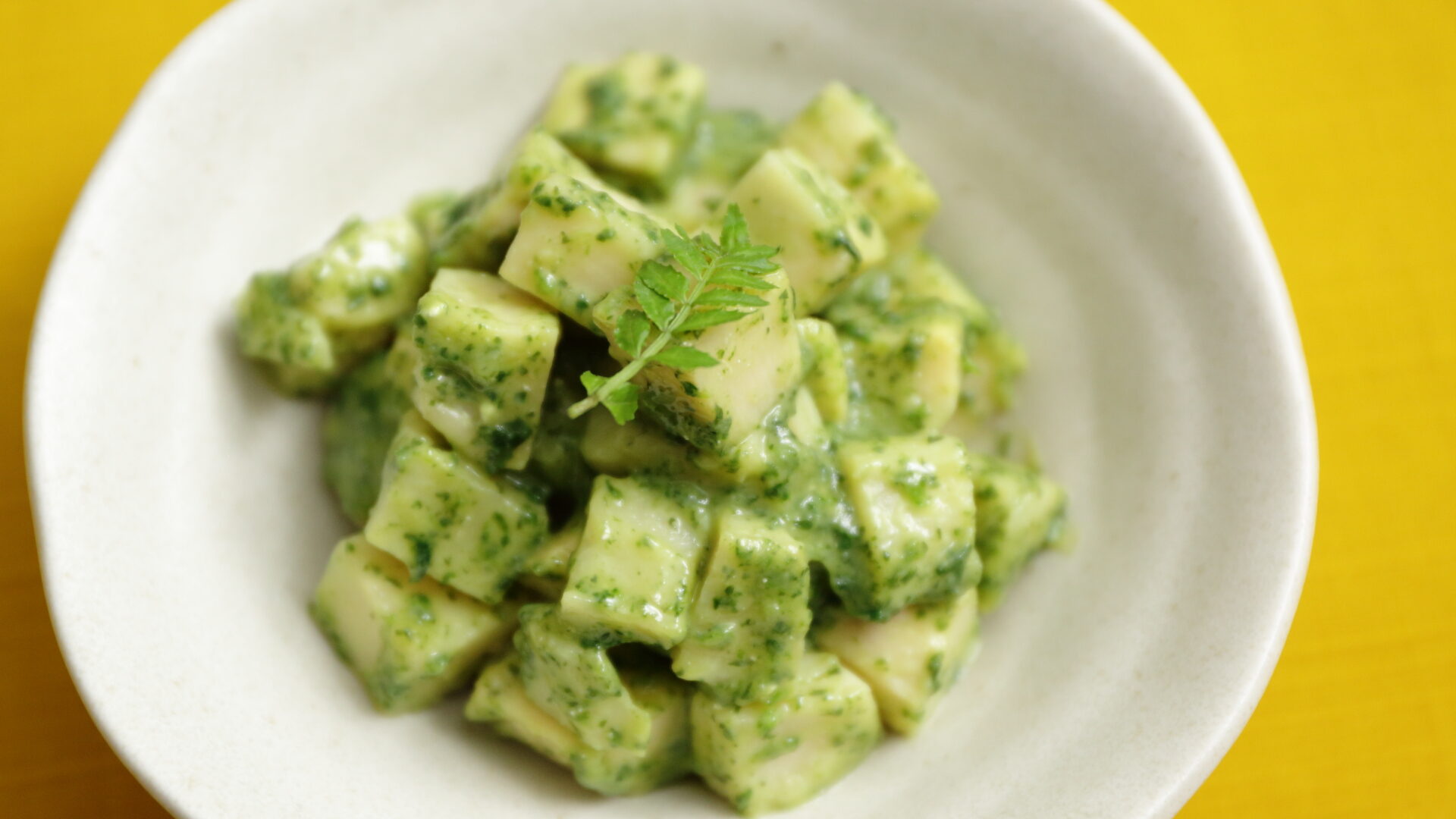
Okay, let’s explore a classic springtime dish from Kyoto: “Takenoko no Kinome Ae.” It’s a delicate and flavorful combination of tender bamboo shoots and fragrant kinome (young sansho pepper leaves). This dish is synonymous with the arrival of spring in Kyoto, showcasing the region’s prized bamboo shoots and the fresh, zesty flavor of kinome.
Dish Name: Takenoko no Kinome Ae / たけのこの木の芽和え
- Region / Location: Yamashiro region, Kyoto City, Kyoto Prefecture.
- Primary Area of Tradition: Yamashiro region and Kyoto City.
- Main Ingredients: Bamboo shoots, kinome (young leaves of the sansho pepper).
How It’s Eaten / Served
“Takenoko no Kinome Ae” is made by combining blanched bamboo shoots with a dressing of kinome, blanched spinach, white miso, sugar, and egg yolk, all ground together in a *suribachi* (Japanese mortar). The bamboo shoots are carefully prepared to remove any bitterness before being mixed with the flavorful *kinome-ae* dressing. The egg yolk adds a glossy sheen and richness to the miso, but it also means the dish doesn’t keep very long, so any leftovers should be refrigerated promptly. The *kinome miso* dressing is also delicious as a variation of *sumiso* (vinegared miso).
Cultural Background and Preservation
Kyoto is famous for its high-quality bamboo shoots, known as “Kyo-takenoko.” These tender, white bamboo shoots are cultivated using a unique method. This method, called the Kyoto-style softening cultivation method, involves several careful steps: “Shindome” (stopping the growth of the mother bamboo), “Shikiwara” (laying straw over the field), and “Tsuchiire” (adding soil to create a deep layer and prevent the bamboo shoot skin from oxidizing and turning black). The Nishiyama region, a major bamboo shoot producing area in Kyoto, has ideal natural conditions for growing bamboo shoots. These conditions include well-draining acidic soil rich in magnesium and plenty of sunny hillsides.
Thanks to this abundance of high-quality bamboo shoots, Kyoto has a rich tradition of enjoying them in various ways during the spring season. Freshly harvested bamboo shoots are enjoyed as sashimi, and dishes like “Takenoko Gohan” (bamboo shoot rice) and “Wakatakeni” (simmered bamboo shoots with wakame seaweed) are also popular. “Takenoko no Kinome Ae” is another classic springtime dish, pairing bamboo shoots with kinome, which is also in season during spring. In fact, the term “Kinome Ae” is so closely associated with bamboo shoots that it’s a widely recognized local dish.
Kyo-takenoko are harvested from early March to late March (early harvest) and from mid-April to early May (peak season). Since both bamboo shoots and kinome are in season during spring, this dish is a quintessential herald of the season.
“Takenoko no Kinome Ae” continues to be prepared in homes across Kyoto every spring, with recipes and techniques passed down through generations. It’s also featured in school lunches and cooking classes, and you can enjoy it at many restaurants.
Additional information:
- Takenoko (筍): Bamboo shoots.
- Kinome (木の芽): Young leaves of the *sansho* pepper plant, known for their unique, fresh aroma.
- Kyo-takenoko (京たけのこ): High-quality bamboo shoots grown in Kyoto.
- Moso-chiku (孟宗竹): A type of bamboo used for Kyo-takenoko cultivation.
- Suribachi (擂鉢): A Japanese mortar and pestle.
- Sumiso (酢味噌): Vinegared miso.
The information about regional cuisine featured on this website (Piggy's Grandma of Japan) is summarized and adapted from the Ministry of Agriculture, Forestry and Fisheries of Japan (MAFF) website, "Our Regional Cuisines"Additional commentary is provided based on the unique experiences and perspectives of the site's editors.
The copyright for the original content regarding regional cuisine belongs to the Ministry of Agriculture, Forestry and Fisheries of Japan.
The summaries and adaptations published on this site are intended for informational purposes only. Piggy's Grandma of Japan does not guarantee the accuracy or completeness of this information. For the most accurate and complete details, please refer to the original pages on the MAFF website.


